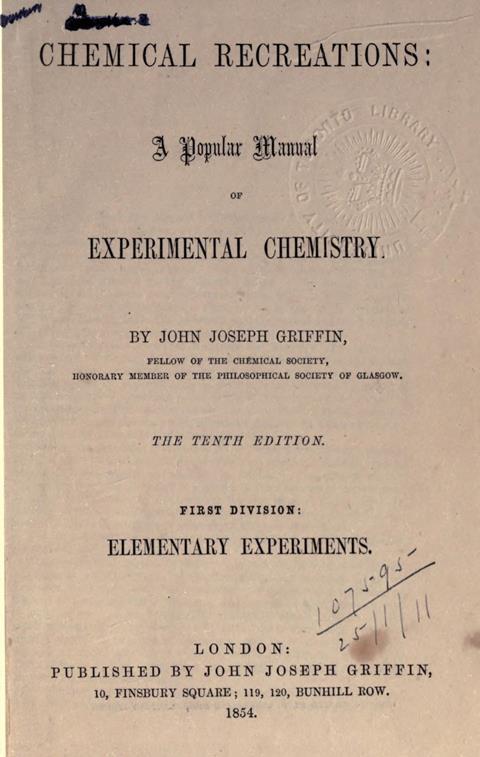What's in a name?
What’s in a name? For many years, on its back page, the magazine New Scientist collected anecdotal data on nominative determinism, the long-held hypothesis that your name has an impact on your future prospects and career. For example, I know a Dr Roger Kneebone, an outstanding teacher of emergency surgery. Chemical examples, however, are thin on the ground.
Hermann Kolbe - whose surname resembles the word for flask in German - was a highly influential, if notoriously prickly, organic chemist. Earlier still, the seventeenth century physician and chymist Johann Becher - ’Becherglas’ is a beaker in German - was the father of the phlogiston theory that would be developed by Georg Stahl. Was young Becher inspired by beakers? He would, no doubt, have used them; the word itself can be derived back through Germanic roots to the Greek word ambikos for a drinking cup. Upturned by Greek alchemists it became a still - hence the Arab word al-ambic; while the Latin word bicarium, in turn gives us the Italian word bicchiere (a drinking glass) and the French pichet (a jug or pitcher). Today in many glassware catalogues, the plain glass container is often called the Griffin beaker.
John Joseph Griffin was born in Shoreditch in London, UK, the area then a far cry from the trendy creative hotspot it is today. His father was a bookseller and publisher who, at some point in John Joseph’s youth, moved the family to Glasgow where his business prospered. Nothing is known of JJ’s early years, but when he finished school he went to one of the top scientific establishments of the day, Glasgow’s Andersonian Institution. Griffin developed a real passion for chemistry. Even after his graduation, while working in his father’s business, he became obsessed with the idea of educating the common working man in the ways of science generally, and chemistry in particular.

In 1823 he published his Chemical recreations. The small volume - printed in octavo format, smaller than a modern paperback - sold out immediately and ran to many editions throughout the 19th century. Its approach was unique - this was not a teacher writing for students, but a more experienced student helping his fellows along the way. The tone is unfailingly enthusiastic and positive, prizing experiment and experience above theory. Above all, Griffin suggested simple ways of adapting or obtaining cheap starting materials and apparatus, pointing out simple short cuts. Among its many readers was the neuropsychiatrist Oliver Sachs, who received a copy from his uncle ’Tungsten’, a gift that would mould his interest in experiment and observation.
The success of his book earned Griffin the respect of his peers and he was active in reviving the Glasgow Philosophical Society. He also travelled in Europe, spending a short period in Leopold Gmelin’s lab in Heidelberg, Germany, around 1832. Although without an academic position, he published a number of polemical academic works, including a vitriolic Romance of chemistry , included in the seventh edition of the Recreations , which presented a new, and as he saw it, improved systematic nomenclature. Alum (hydrated potassium aluminium sulfate), for example, would become Kalialintriasulintetraoxinocta Aquindodeca . He reserved particular scorn for the notation of the great Swedish systematiser and analyst J?ns-Jakob Berzelius, and felt it necessary to send a copy of his book to the great man. Nonplussed, Berzelius ignored it.
Academic reception to Griffin’s proposals was frosty - indeed Jean-Baptiste Dumas in Paris ridiculed Griffin’s suggestions in his lectures - and the topic vanished from subsequent editions of the Recreations. But as sales continued to grow, Griffin began to supply apparatus through the business he had inherited from his father. Trips to Germany gave him exclusive distribution rights for a number of first class instrument and glassware manufacturers. He sold beakers, equipped with spouts and graduations, in large numbers and a host of other equipment. The name Griffin distinguished his squat beakers from, ironically, the taller Berzelius beaker. Moving back to London, Griffin expanded a business that eventually would be taken over by his children on his death in 1877. Mergers would transform the firm into the legendary Griffin & George - suppliers to schools and universities in Britain and the former colonies, and the name lives on.
And beakers, whether Griffin’s or Berzelius’s, remain one of the first pieces of glassware we learn the name of. Would life be any different if it were called something different? Would that which we call a beaker by any other name smell as sweet?
Andrea Sella teaches Chemistry at University College London, UK
References
I am, once again, indebted to Bill Brock for valuable insights.












No comments yet